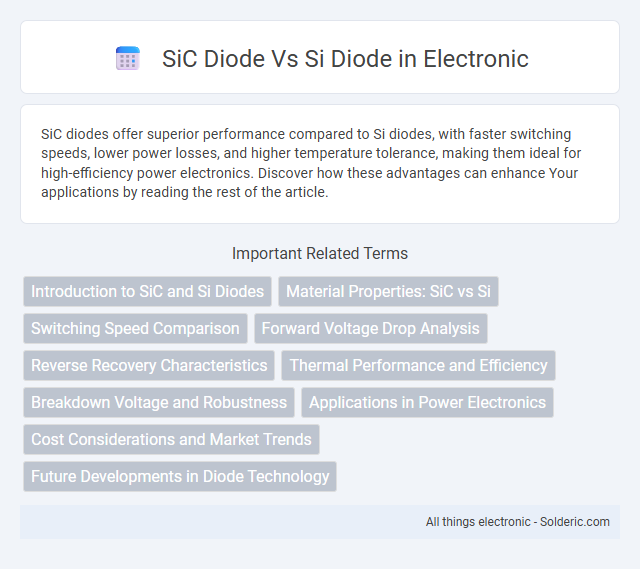SiC diodes offer superior performance compared to Si diodes, with faster switching speeds, lower power losses, and higher temperature tolerance, making them ideal for high-efficiency power electronics. Discover how these advantages can enhance Your applications by reading the rest of the article.
Comparison Table
| Feature | SiC Diode | Si Diode |
|---|---|---|
| Material | Silicon Carbide (SiC) | Silicon (Si) |
| Switching Speed | High (fast recovery) | Lower (slower recovery) |
| Forward Voltage Drop (Vf) | Higher (~1.4 V) | Lower (~0.7 V) |
| Reverse Recovery Time | Ultra-low (ns range) | High (us range) |
| Operating Temperature | Up to 175degC - 300degC | Up to 125degC |
| Thermal Conductivity | High (~3.7 W/cm*K) | Lower (~1.5 W/cm*K) |
| Efficiency | Higher in high-frequency, high-voltage applications | Lower efficiency in such conditions |
| Cost | Higher (more expensive) | Lower (cost-effective) |
| Typical Application | High-power electronics, EV inverters, renewable energy | General-purpose electronics, low to medium power |
Introduction to SiC and Si Diodes
Silicon Carbide (SiC) diodes offer superior performance compared to traditional Silicon (Si) diodes due to their wider bandgap of 3.26 eV versus 1.12 eV for silicon, enabling higher voltage and temperature operation. SiC diodes exhibit lower forward voltage drop and faster switching speeds, resulting in improved energy efficiency and reduced heat dissipation in power electronics. These characteristics make SiC diodes ideal for high-power, high-frequency applications where silicon diodes face limitations.
Material Properties: SiC vs Si
Silicon Carbide (SiC) diodes exhibit superior material properties compared to Silicon (Si) diodes, including a wider bandgap of approximately 3.26 eV versus 1.12 eV for Si, enabling higher temperature operation and greater breakdown voltage. SiC's higher thermal conductivity, around 3.7 W/cm*K compared to Si's 1.5 W/cm*K, allows for better heat dissipation and enhanced device reliability under high power conditions. The inherently higher electric field strength of SiC, roughly 10 times that of Si, enables smaller, more efficient device designs with reduced switching losses in power electronics.
Switching Speed Comparison
Silicon Carbide (SiC) diodes exhibit switching speeds significantly faster than traditional Silicon (Si) diodes due to their wider bandgap and lower charge storage. SiC Schottky diodes typically achieve reverse recovery times in the order of nanoseconds, while Si PN diodes often experience microseconds of recovery time, leading to reduced switching losses and higher efficiency in power electronics. This rapid switching capability makes SiC diodes ideal for high-frequency applications such as electric vehicles, renewable energy inverters, and power supplies.
Forward Voltage Drop Analysis
Silicon Carbide (SiC) diodes exhibit a significantly lower forward voltage drop compared to traditional Silicon (Si) diodes, typically around 1.2V for SiC versus 1.7V for Si. This reduced forward voltage drop in SiC diodes leads to higher efficiency and lower power loss in high-voltage, high-temperature applications. The intrinsic material properties of SiC, such as wider bandgap and higher electric field breakdown strength, contribute to their superior forward voltage characteristics.
Reverse Recovery Characteristics
Silicon Carbide (SiC) diodes exhibit significantly faster reverse recovery times compared to Silicon (Si) diodes, resulting in reduced switching losses and enhanced efficiency in high-frequency power electronics. The lower reverse recovery charge (Qrr) of SiC diodes minimizes electromagnetic interference (EMI) and thermal stress during switching events. This superior reverse recovery characteristic makes SiC diodes ideal for applications requiring high-speed switching and robust performance under high voltage and temperature conditions.
Thermal Performance and Efficiency
Silicon carbide (SiC) diodes exhibit superior thermal performance compared to traditional silicon (Si) diodes due to their higher bandgap energy of approximately 3.26 eV, allowing operation at junction temperatures exceeding 200degC, whereas Si diodes are limited to around 150degC. SiC diodes demonstrate lower forward voltage drop and reduced switching losses, resulting in enhanced efficiency and reduced heat generation during high-frequency and high-power applications. The improved thermal conductivity of SiC, around 3.7 W/cm*K, significantly surpasses that of silicon (~1.5 W/cm*K), enabling more effective heat dissipation and longer device reliability under demanding conditions.
Breakdown Voltage and Robustness
SiC diodes offer significantly higher breakdown voltage, often exceeding 1,200V, compared to traditional Si diodes typically rated around 600-800V. This enhanced voltage tolerance results from SiC's wide bandgap properties, making SiC diodes more robust in high-voltage and high-temperature environments. Choosing a SiC diode can improve your circuit's reliability and durability under demanding electrical stress.
Applications in Power Electronics
SiC diodes offer significantly higher efficiency and faster switching speeds than traditional Si diodes, making them ideal for high-power and high-frequency power electronics applications such as electric vehicle inverters and renewable energy systems. Their superior thermal stability and lower reverse recovery charge reduce power losses and improve system reliability in harsh environments. Si diodes remain common in low-voltage applications where cost sensitivity outweighs performance requirements, but SiC technology is rapidly becoming the standard in advanced power electronics.
Cost Considerations and Market Trends
Silicon carbide (SiC) diodes generally have higher initial costs compared to traditional silicon (Si) diodes due to complex manufacturing processes and material expenses. However, SiC diodes offer significant long-term savings by enhancing energy efficiency and thermal performance in high-power applications, driving increasing adoption in electric vehicles and renewable energy sectors. Market trends indicate a growing preference for SiC diodes as production scales up, gradually reducing costs and expanding their competitive edge over silicon diodes.
Future Developments in Diode Technology
Silicon carbide (SiC) diodes offer significant advantages over traditional silicon (Si) diodes, including higher efficiency, faster switching speeds, and improved thermal performance, making them ideal for future power electronics applications. Advancements in SiC diode technology are driving innovations in electric vehicles, renewable energy systems, and high-frequency power conversion by reducing energy losses and enhancing durability. Your choice of diode technology can significantly impact the efficiency and sustainability of next-generation electronic devices.
SiC diode vs Si diode Infographic

 solderic.com
solderic.com